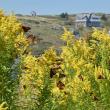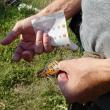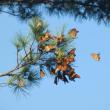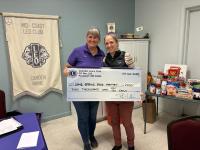Kristen Lindquist: Masses of Monarchs on Monhegan!
 Monarchs on the island were concentrated primarily on the goldenrod and asters. (Photo by Kristen Lindquist)
Monarchs on the island were concentrated primarily on the goldenrod and asters. (Photo by Kristen Lindquist) Monarch butterflies on Monhegan this fall filled the air over our heads like that familiar scene in “Bambi.” (Photo by Kristen Lindquist)
Monarch butterflies on Monhegan this fall filled the air over our heads like that familiar scene in “Bambi.” (Photo by Kristen Lindquist) Bryan Pfeiffer shows how to identify the sex of a monarch. (Photo by Kristen Lindquist)
Bryan Pfeiffer shows how to identify the sex of a monarch. (Photo by Kristen Lindquist) Bryan Pfeiffer demonstrates proper monarch tag placement. (Photo by Kristen Lindquist)
Bryan Pfeiffer demonstrates proper monarch tag placement. (Photo by Kristen Lindquist) A monarch roost before it has fully awakened in the morning.
A monarch roost before it has fully awakened in the morning. A recently tagged monarch rediscovered on the island. (Photo by Bill Thompson)
A recently tagged monarch rediscovered on the island. (Photo by Bill Thompson)
 Monarchs leave their roost when it has warmed up enough for them to fly. (Photo by Kristen Lindquist)
Monarchs leave their roost when it has warmed up enough for them to fly. (Photo by Kristen Lindquist) Distinct dark spots along a vein on the hindwing show that this monarch is male. (Photo by Kristen Lindquist)
Distinct dark spots along a vein on the hindwing show that this monarch is male. (Photo by Kristen Lindquist)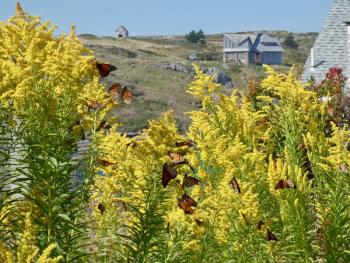 Monarchs on the island were concentrated primarily on the goldenrod and asters. (Photo by Kristen Lindquist)
Monarchs on the island were concentrated primarily on the goldenrod and asters. (Photo by Kristen Lindquist) Monarch butterflies on Monhegan this fall filled the air over our heads like that familiar scene in “Bambi.” (Photo by Kristen Lindquist)
Monarch butterflies on Monhegan this fall filled the air over our heads like that familiar scene in “Bambi.” (Photo by Kristen Lindquist) Bryan Pfeiffer shows how to identify the sex of a monarch. (Photo by Kristen Lindquist)
Bryan Pfeiffer shows how to identify the sex of a monarch. (Photo by Kristen Lindquist) Bryan Pfeiffer demonstrates proper monarch tag placement. (Photo by Kristen Lindquist)
Bryan Pfeiffer demonstrates proper monarch tag placement. (Photo by Kristen Lindquist) A monarch roost before it has fully awakened in the morning.
A monarch roost before it has fully awakened in the morning. A recently tagged monarch rediscovered on the island. (Photo by Bill Thompson)
A recently tagged monarch rediscovered on the island. (Photo by Bill Thompson)
 Monarchs leave their roost when it has warmed up enough for them to fly. (Photo by Kristen Lindquist)
Monarchs leave their roost when it has warmed up enough for them to fly. (Photo by Kristen Lindquist) Distinct dark spots along a vein on the hindwing show that this monarch is male. (Photo by Kristen Lindquist)
Distinct dark spots along a vein on the hindwing show that this monarch is male. (Photo by Kristen Lindquist)When I visited Monhegan, a small island about 10 miles off the coast of Maine, this past Labor Day weekend, I witnessed a heartening number of monarch caterpillars, chrysalides, and flying adult butterflies. As I noted in last month’s piece about the metamorphosis and fall migration of these amazing insects, this resurgence of monarchs may be a hopeful sign that the eastern US population, at least, had a good year.
Then I returned to the island for a more extended stay a couple of weeks later. In the 22 years I have visited Monhegan for the fall migration, I have never seen anything like what I experienced this time around. And I’m not talking about the birds, I’m talking about butterflies. Thousands of them. Everywhere.
Among the island’s residents and visitors, the sheer number of butterflies flying around us became a shared parlance. We bonded over butterflies. Healthy patches of goldenrod and aster laden with dozens of feeding butterflies became common stops for shared admiration and conversation along the hiking trails and in town.
One particular spot in heart of the village consistently hosted hundreds of butterflies feeding and flitting in the air above a large patch of seven-foot high goldenrod that swayed in the sea breeze. The effect could only be described as “magical” by those observing below. As one person noted with awe, she could hear their wings as they flew around her. Several people mentioned feeling as if they were in a Disney moment, surrounded by flapping butterflies just like young Bambi in the classic animated film. Many iPhone videos were made—none of which could properly convey the wonder of the experience.
As I roamed around at sun-up each morning, hoping to see arriving migrant songbirds, I also began to notice monarch butterfly roosts high in some of the spruces and pines. Insects cannot regulate their own body heat, so they basically can’t move when their bodies are too cold. Migrating monarchs will often cluster together in nocturnal roosts high in trees, especially if the nights are cold. I had only come upon a small roost of monarchs once before, years earlier, so I marveled to find multiple roosts now, with hundreds of butterflies in each.
The conifers’ needles, as well as the tight clusters of butterfly bodies themselves, help shelter the insects from the overnight chill. The spruce and pine trees around the Monhegan brewery seemed to be a preferred roosting area, as well as another spruce grove in Lobster Cove. I heard from some brewery visitors that they had watched butterflies joining the roosts early the previous evening, around the time of last call.
To find a monarch roost first thing in the morning is a bit like finally seeing one of those 3-D hidden pictures. The butterflies fold their wings up flat so that the duller colored undersides are all that’s visible. In low light, these underwings blend in remarkably well with dead needles and cones on the spruce boughs. It’s only when sunlight begins to strike the roost and warm up the butterflies that you really start to notice: one or two monarchs begin to open their wings, flapping the bright orange topsides like semaphores, and suddenly you see them… and dozens more still closed up tight all around. As the morning progresses, one by one the butterflies leave the roost, at first just out and back, or to a different perch. Eventually, they’ve all dispersed to refuel on nectar among the flower gardens and scattered patches of wildflowers around the island. Perhaps today will be the day they will head out over the ocean and fly a little farther south, en route to Mexico.
While on the island I had the good fortune to be able to participate in a large-scale citizen science project of the organization Monarch Watch by helping my friend Bryan Pfeiffer tag monarchs. As the Monarch Watch website explains: “Tagging was originally used…[to] help locate overwintering monarchs and later to determine where monarchs came from that wintered in Mexico. [The] long-range tagging program at Monarch Watch continues to reveal much more…about the origins of monarchs that reach Mexico, the timing and pace of the migration, mortality during the migration, and changes in geographic distribution.”
Bryan, who has tagged butterflies for nearly 20 years, showed up on the island with 300 Monarch Watch butterfly tags and an extra net. With his experience, he was able to sweep up six butterflies at a time in his net before stopping to tag them. I managed to catch one about every dozen tries, but eventually got the hang of it. There were so many butterflies clustered on trailside flowers that it was almost impossible not to catch one. In fact, some were so involved in feeding that you could easily catch them with your bare hands.
Once I finally caught one, I would reach into the net, gently press all four of the butterfly’s wing parts closed around its thorax with my thumb and forefinger, and carefully pull it out flat. The tags are tiny round white stickers containing three lines of text: “MWTag.org / Monarch Watch /[a unique number]. These stickers are backed with a strong adhesive that sticks easily to the butterfly’s wing when pressed lightly.
Each tag was stuck to the discal cell—an orange area roughly the shape of a mitten—on the monarch’s hind underwing. These tags are very light, and do not interfere with the butterfly’s flight in any way. Usually the tagged insect would fly off immediately and vigorously upon release. This southward migrating generation of monarchs is, relatively speaking, bigger and stronger than prior generations; wings built to potentially fly two-thousand miles or more can handle a tiny tag.
On the first day we tagged, the island’s butterfly population seemed to be one big stag party: we caught 34 male monarchs in a row, over various locations. Maybe the females were too smart to get caught in our nets.
The spreadsheet of information that Bryan will submit to Monarch Watch includes the sex, tagging location, and date linked to each tag number. If one of our tagged butterflies were to be recovered, the finder could then log into MWTag.org and find out where it came from. Monarch Watch reports that most of its recovered tags are found in the overwintering sites in central Mexico. The organization pays local guides and farmers the equivalent five US dollars for each tagged butterfly they find among the masses of mostly untagged butterflies.
The odds are very slim that one of the butterflies Bryan, me, and others tagged on Monhegan will be recovered. Over the years, Bryan has been notified about the recovery in Mexico of only four butterflies he’d tagged, each of which originated in his home state of Vermont.
Monarchs have the ability to fly up to 100 miles a day. So I’m imagining all the ones we tagged out there even now, winging their way south. A recent NOAA posting showed a cloud of butterflies and dragonflies migrating over Oklahoma that was so big it registered on weather radar. I like to think some of “our” butterflies were in that cloud, almost home.

By early October, most of the monarchs massed on the island had dispersed, migrating southward ahead of killing frosts. Before they left, I took dozens of photos in an inadequate, even desperate, attempt to capture the experience. Knowing what our insect populations are up against these days, I have only a small hope that I will ever enjoy a butterfly migration like that again in my lifetime. It was, after all, just a few years ago that we saw only two monarchs out on Monhegan in September. But a small hope is still hope, and I’ll hold onto that hope as if it were a butterfly.
Kristen Lindquist is an amateur naturalist and published poet who lives in her hometown of Camden.
Event Date
Address
United States









